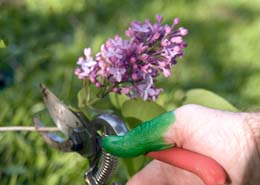If you are lucky enough to have lilacs in your flower garden, you would definitely like to know how to prune lilac bushes. Knowing the answer to this commonly asked doubt is very necessary for the maintenance of these plants.

Wish to lend a neat, groomed look to your garden? You need to maintain good plant care, and resort to pruning, from time to time. Lilac bushes are some of the plants which need this for proper, orderly growth. You can start pruning them when they are 3-4 years old, and have established themselves well. In their case, it is important not only to prune, but also to do so at the right time of the year. Here are certain tips that may guide you on how to prune lilac bushes.
Prune In Late Spring: You must have observed that the lilac bushes bloom only on old growth. Prune them right after they have finished blooming, and before they have started budding for the next year's show. They are perennial plants that bloom in the spring, and start shedding-off flowers by the end of the season. This is the best time to prune them, to clear out old flowers, branches, and leaves. By the end of June or July, the bushes start budding. If you trim the branches that have started bearing buds, you might lose a consistent quantity of flowers the following spring. Hence, make it a point to avoid pruning the bushes in late June or July. This would preserve the branches that would bear flowers the next year. If you happen to cut down the branches that have started budding, the penalty can be as bad as the lilac plant not blooming for about five years. For this reason, you need to be highly careful with the timing.
Maintain Its Shape: The natural shape of a lilac bush is that of a flower vase. Each year, new growth clusters at the base, and the upper portion spreads out in all directions. This gives the plant a wild appearance, and spoils your landscape design. Prune the bushes so that they do not fan out. Your aim should be to maintain the vase-like shape. Since lilacs can grow from 4 to 30 feet, their height depends on your choice. Trim them accordingly.
Cut off Flowers, Shoots, Suckers, and Runners: You would find the base of the lilac plant clumped with old and wilted flowers. You would also see many branches, runners, and suckers overgrowing in all directions. They all need to be cut down in order to give a clean look. For a typical vase-like shape, the growth of the plants should be more upwards than downwards. Any downward growing branch must be cut off. While pruning, make sure that you leave at least a few healthy, strong, and new stalks for the next blooming season.
Trim Old Branches: Many branches grow such that they cross one another. If this is the case in your bush, trim those branches down. Pruning of the old flowers, shoots, suckers, runners, and leaves aid in better aeration of the lilac plant, and also promote new growth on it. Generally, old branches are woody and hard. You might need a sharp saw to cut them down.
Remove the Old Wood: Remove the old wood every year. As the plant grows, the amount of wood increases. The wood, if not removed, creates a visible hole in the center of the lilac bush. Allow the new shoots to cover this hole, and replace the old wood. If the plant is new, light pruning will be enough. But, if they are old, overgrown shrubs and bushes, you need to cut all the unnecessary shoots. This would stimulate the plant to blossom profusely the following year.
Pruning is not only important for maintaining the shape of the lilacs, but also to protect them from certain insects and pathogenic micro-organisms. When you find an infected branch, the best thing to do is to cut down the complete branch. Otherwise, the disease-causing agents might invade other parts of the same plant, or other plants altogether. Hence, pruning lilac bushes has a very important role to play in the upkeep of your garden landscaping.






 Wish to lend a neat, groomed look to your garden? You need to maintain good plant care, and resort to pruning, from time to time. Lilac bushes are some of the plants which need this for proper, orderly growth. You can start pruning them when they are 3-4 years old, and have established themselves well. In their case, it is important not only to prune, but also to do so at the right time of the year. Here are certain tips that may guide you on how to prune lilac bushes.
Wish to lend a neat, groomed look to your garden? You need to maintain good plant care, and resort to pruning, from time to time. Lilac bushes are some of the plants which need this for proper, orderly growth. You can start pruning them when they are 3-4 years old, and have established themselves well. In their case, it is important not only to prune, but also to do so at the right time of the year. Here are certain tips that may guide you on how to prune lilac bushes.